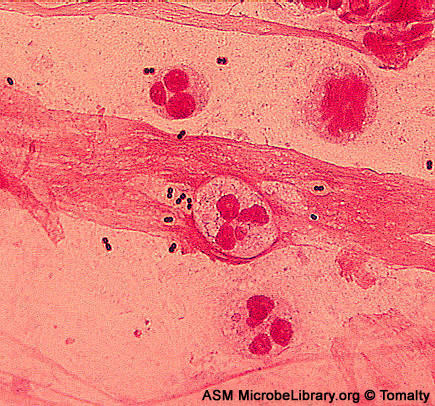 |
Case 10 |
 |
Case 10 |
Gerry presents with fever, cough and left-sided chest pain. His vital signs were temperature; 104 degrees F, heart rate; 110/min, respirations; 27/min, and bp; 145/85. He mentioned having a upper respiratory tract infection about two weeks ago. He started feeling better about three days ago. However, last night he experienced a shaking chill and recorded a body temperature of 102.5 degrees F. He complains of left sided chest pain that is worse on inspiration. Examination reveals chest splinting on inspiration, left sided rales and wheezes, and dullness to percussion over the left lower lung. Sputum was obtained for gram stain and culture. A blood sample was obtained for CBC and culture. The patient was sent to the radiology department for tests.
CBC: Leukocyte count: 13,000/microliter (Normal 4500-11,000/microliter)
Differential |
Cell Number |
Normal Value (%) |
Neutrophils |
9500 |
40-60 |
Lymphocytes |
2600 |
20-40 |
Monocytes |
370 |
4-8 |
Eosinophils |
10 |
1-3 |
Basophils |
10 |
0-1 |
Bands |
500 |
0-5 |
A. You believe he has pneumonia. Which of the following would be the most appropriate and least invasive means of confirming your diagnosis?
B. Which of the following is the best description of the patient's CBC?
Chest film came up on EMR see below |
Gram Stain of Sputum |
 |
 |
C. Using the patient's signs and symptoms and laboratory findings which of the following is the most appropriate diagnosis?
D. Which of the following is the most likely cause of this patient's current condition?
© 1996-2013 Neal Chamberlain. All rights reserved.
Site Last Revised 12/18/13
Neal Chamberlain, PhD. A. T. Still University of Health Sciences/Kirksville College of Osteopathic Medicine.
Take Care and Think Microbiologically!